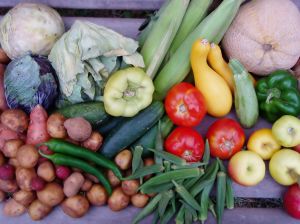By Rita Brhel, managing editor and attachment parenting resource leader (API)
 Sadly, the challenge of encouraging your child to eat nutritiously doesn’t get any easier as he grows. As they become more independent thinkers, school-aged children and teens are exposed to more people modeling unhealthy behaviors: their peers and friends, other adults in the community, television commercials, even school vending machines promoting quick, easy, and tasty sweets and fatty foods.
Sadly, the challenge of encouraging your child to eat nutritiously doesn’t get any easier as he grows. As they become more independent thinkers, school-aged children and teens are exposed to more people modeling unhealthy behaviors: their peers and friends, other adults in the community, television commercials, even school vending machines promoting quick, easy, and tasty sweets and fatty foods.
Role models don’t have to openly discourage eating nutritiously; ignoring healthy options and choosing junk food first is powerful persuasion.
As children grow, eventually what peers teach begins to compete with the importance of parental guidance. But, in a family that values strong parent-child attachments, the parent will continue to be the top role model. So, even if your teen’s friends are choosing candy bars and pop over healthy snacks and beverages, she’s still learning most of her life lessons from what’s going on at home.
Here are a few ways parents can positively influence their children’s food choices:
- Lead by example – Your child, even a teen, is learning how to live life by watching what you do and doing it, so if you’re snacking on chips and candy, your child will be, too. Also, actions speak louder than words. Your child learns more from watching what you eat than by listening to you advocate for the apple while you’re munching on a cookie.
- Cheer up! – Many people, children and adults, learn to eat when they’re unhappy. Help your child find other ways to work through their feelings, such as talking with you or a friend.
- Beat the boredom – Some children eat when they’re bored, especially while watching television. Turn off the TV and turn on family time with games, outings, or other activities together. In addition to discouraging your child from eating while viewing, turning off the television will reduce the time your child is exposed to junk food advertisers.
- Moderation is the key – An occasional sweet is OK, but limiting the portion is a must. Teach your child to limit junk food by eating chips only with healthy meals and only offering one or two cookies during one snack time. Be consistent and resilient against protests, especially if you’re starting to change your child’s eating habits.
- Make your own “junk food” – Bypass the store-bought processed foods by making your own candy, ice cream, sweet breads, and chips. Learn ways to make recipes healthier, such as using skim milk instead of whole milk and using applesauce instead of sugar.
- Prepare quick foods for your busy teen – Many older children and teens have extremely full schedules, running from sports practice to dance class to church activities before coming home to do schoolwork and getting ready for bed. Junk food is notoriously easy for them to get quick energy, even if it’s not healthy energy. Encourage your child to eat well when they’re looking for quick meals by preparing healthy, tasty snacks for them. Cheese and crackers, a banana, celery sticks with peanut butter are all easy to pack together and don’t have to be refrigerated.
There will still be times when your child or teen opts for a bag of chips and pop instead of a healthier choice, but the goal is to teach her to make the right choice from how you model what to eat. And be creative! Healthy food choices can compete with the sugar- and fat-packed junk food. Find recipes that appeal to your child’s sweet tooth but still give her some nutrition, like a fruit-nut trail mix or multi-grain cookies.

